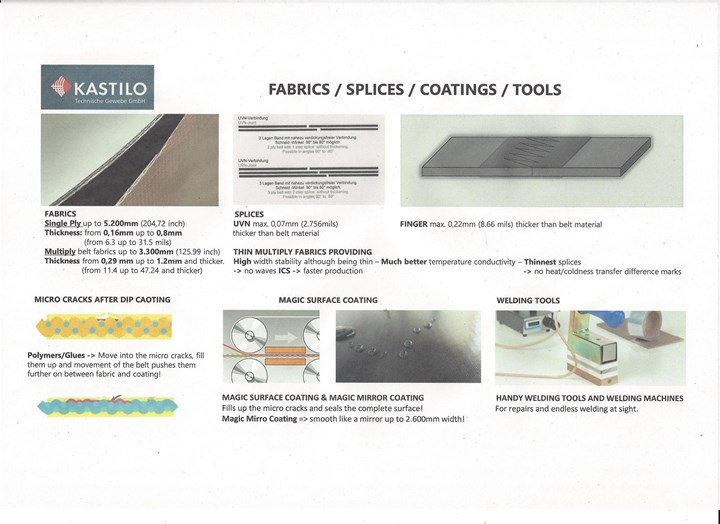CAMX 2022 exhibit preview: Kastilo Technical Fabrics GmbH
Kastilo highlights its specialization in PTFE-coated fabrics and belts, including its Magic Surface film lamination coating and PTFE-coated Multiple fabric/belts.
Kastilo Technical Fabrics GmbH (Ulm-Einsingen, Germany) is known for its high-quality and innovative manufacturing technologies, particularly its polytetrafluorethylene (PTFE) and silicone-coated glass and aramid fabrics, as well as conveyor belts, which are designed based on individual customer and application requirements.
The company specifically highlights its Magic Surface coating, a film lamination for standard PTFE-coated fabrics and belts. The film coating seals any microcracks or other imperfections in the PTFE dip-coated surface to avoid material sticking, the company says. Magic Surface provides a high release, easy cleaning and long coating life when polyurethane, polyethylene, sticky chemicals like EVAs and other glues and chemicals are in use. Magic Surface is applicable for products developed in the automotive, chemical, composites, hygenic, pharmaceutical and recycling industries
High width stability and very good thermal conductivity are features needed for the production process of composite products, Kastilo points out, especially composite boards. PTFE-coated single-ply fabrics need to be thicker for a good width stability but the thicker the fabric, the lower the thermal conductivity. Kastilo highlights its PTFE-coated Multiply fabrics/belts to solve this challenge. With widths up to 125.9", the company says the fabrics are much thinner — to achieve required thermal conductivity — but also have a high width stability due to Kastilo’s undisclosed laminating process for a strong material.
Other materials like PTFE-coated open mesh fabrics with opening sizes of 2x2 mm, 4x3 mm, 4x4 mm and 6x6 mm and up to 204" in width are available. According to Kastilo, these fabircs are needed to prepare the composite material components and nonwoven fleece and felts through a dryer for thermobonding. The wider the belt fabric, the more stability is needed to keep the belt flat. The company’s double weft yarn fabrics give a high width stability for an even product outcome.
Related Content
-
Novel dry tape for liquid molded composites
MTorres seeks to enable next-gen aircraft and open new markets for composites with low-cost, high-permeability tapes and versatile, high-speed production lines.
-
Materials & Processes: Composites fibers and resins
Compared to legacy materials like steel, aluminum, iron and titanium, composites are still coming of age, and only just now are being better understood by design and manufacturing engineers. However, composites’ physical properties — combined with unbeatable light weight — make them undeniably attractive.
-
Materials & Processes: Fibers for composites
The structural properties of composite materials are derived primarily from the fiber reinforcement. Fiber types, their manufacture, their uses and the end-market applications in which they find most use are described.














